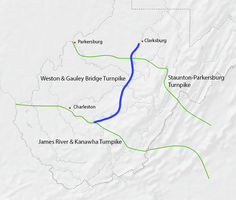 | Back to e-WV
| Back to e-WV
 The West Virginia Encyclopedia
The West Virginia Encyclopedia
 | Back to e-WV
| Back to e-WV
 The West Virginia Encyclopedia
The West Virginia Encyclopedia

In 1849, work began on the Weston & Gauley Bridge Turnpike, which eventually stretched nearly 110 miles through a rugged Appalachian landscape. When completed, the road connected the Staunton-Parkersburg Turnpike at Weston with the James River & Kanawha Turnpike at Gauley Bridge. It was one of the few north-south turnpikes built in the antebellum period.
The Weston & Gauley Bridge Turnpike Company was authorized by the Virginia General Assembly March 25, 1848, with a capital stock of $30,000. The Board of Public Works formula for financing numerous turnpike roads was to establish a private stock company, with the board subscribing three-fifths of the stock, in this case $18,000. Later, another $15,000 was authorized, bringing the total capital stock to $45,000. Local governments supplied most of the funds not provided by the state, with individuals buying only a few shares. The turnpike was built with a cleared 30-foot right of way and a road width of 15 feet, and at grades not exceeding five degrees. The Weston & Gauley Bridge Turnpike was simply an improved dirt road. The turnpike began in Weston, passed through the salt works at Bulltown, crossed the Elk River at Sutton, then traveled to Summersville, and ended on the Kanawha River at Gauley Bridge. There were notable covered bridges over the West Fork at Bendale, just south of Weston, and over the Little Kanawha River at Bulltown. The most significant structure, however, was the wire suspension bridge crossing the Elk River at Sutton. This bridge was built by Ira Hart with the wire being supplied by Bodley and Company of Wheeling. Despite problems with the construction and financing, the bridge was open for traffic in 1857 and served until 1930.
The Weston & Gauley Bridge Turnpike was completed in 1858. During the Civil War, troops from North and South reduced the road surface to a dismal state, according to contemporary accounts. In addition, it was extremely difficult to collect tolls to maintain the road during the war. Following West Virginia statehood in 1863, all of the turnpikes in the new state were turned over to the counties through which they ran. Money was scarce, and little was done to maintain these roads. It was not until the 1920s that U.S. 19, which generally follows the path of the original turnpike, was surfaced. There are a number of sections of the old road in essentially original condition, including one at Bulltown.
Written by Emory L. Kemp
Kemp, Emory L. Links in a Chain: The Development of Suspension Bridges, 1801-1870. London: Institution of Structural Engineers, 1979.
Kemp, Emory L. & Beverly B. Fluty. The Wheeling Suspension Bridge. Charleston: Pictorial Histories Publishing Company, 1999.
Kemp, Emory L. Charles Ellet Jr. and the Wheeling Suspension Bridge. Proceedings of an International Conference on Historic Bridges. Morgantown: West Virginia University Press, 1999.
Kemp, Emory L. "Roebling, Ellet and the Wire Suspension Bridge," in Margaret Latimer, et al., eds, Bridge to the Future: A Centennial of the Brooklyn Bridge. New York: Academy of Sciences, 1984.
Kemp, Emory L. & Janet Kemp. Building the Weston and Gauley Bridge Turnpike. West Virginia History, (Summer 1980).